Bayesian Channel Estimation for Massive MIMO
Communications
Chengzhi Zhu, Zhitan Zheng, Bin Jiang, Wen Zhong, and Xiqi Gao
National Mobile Communications Research Laboratory, Southeast University, Nanjing 210096, P. R. China
Email: {bjiang, xqgao}@seu.edu.cn
Abstract—In this paper, we derive the Bayes-Optimal estimator
based on approximate message passing (AMP) algorithm in
massive multiple-input multiple-output (MIMO) systems, which
requires statistical channel state information (CSI). According to
the analysis of channel model in beam domain, the convariance
matrix is derived for CSI acquisition. With the aid of statistical
CSI, the convergence of the proposed algorithm has significant
improvement in comparison with which use the expectation-
maximization (EM) algorithm to fit the statistical CSI. Sim-
ulations show great mean squared error (MSE) performance
that approximates the Minimum Mean Square Error (MMSE)
estimator, and better convergence performance than other AMP
algorithm can be achieved. Besides,
the results prove that
performance of the random pilot in this algorithm is close to
that of the orthogonal pilot based on Zadoff-Chu sequences.
I. INTRODUCTION
Massive MIMO systems, which employ a large number of
antennas at the base station (BS) to simultaneously serve a
relatively large number of users [1], are believed to be one of
the key candidate technologies for forthcoming 5G wireless
networks [2], [3] with the potential large gains in spectral
efficiency and energy efficiency.
Channel state information which is typically obtained with
the assistance of the periodically inserted pilot signals [4],
plays a significant role in massive MIMO transmission. CSI
makes it possible to adapt transmissions to current channel
conditions, which is crucial for achieving robust communica-
tion in massive MIMO systems. Due to the fact that statistical
CSI varies over much longer time scales than instantaneous
CSI, we use statistical CSI instead of instantaneous CSI. And
more importantly, statistical CSI requires much less over-
head. MIMO channel estimation based on Gaussian-Mixture
Bayesian learning has been investigated in [5], [6]. Instead
of using expectation-maximization (EM) [5]–[7] algorithm to
learn the channel properties, we use statistical CSI as known
properties to reduce the complexity and improve the perfor-
mance of AMP algorithm. In massive MIMO systems, accurate
statistical CSI is required not only in channel estimation, but
also in other aspects [8], [9], such as user scheduling .
In this work, we model each channel element in the beam
domain as a Gaussian variable. This model enables a more
accurate learning of AMP algorithm,
in comparison with
Gaussian-Mixture. We can reconstruct the channel components
with great mean-squared error (MSE) performance which is
close to LMMSE channel estimation.
Throughout this paper, we use the following notation: C
denotes the set of complex numbers. We use ai;j to denote
the (i; j)th element of matrix A. AT denotes the transpose of
A and AH denotes the conjugate transpose of A. Identity
matrix is denoted by IK. E{·} represents the expectation
operation. x ∼ NC(; 2) denotes a random complex variable
x comply with the complex Gaussian distribution with mean
and variance 2, where
(
−|x − |2
)
:
2
fX (x) =
1
2 exp
II. SYSTEM MODEL
We consider single-cell TDD massive MIMO wireless trans-
mission scheme which consists of one BS equipped with N
antennas and K single-antenna users. Assume that the BS is
equipped with a uniform linear array (ULA), and the antennas
are separated by half wavelength.
We assume that the uplink pilot S ∈ CL×K where L
denotes the pilot length. We use hk;n to represent the channel
coefficient of kth user and nth beam in the beam domain [8].
With these definitions, the received signal of the lth symbol
in the nth beam can be written as
sl;khk;n + zl;n = sT
l hn + zl;n;
(1)
K∑
yl;n =
k=1
where sl;k represents lth symbol of the kth user’s pilot signal,
zl;n is the Gaussian noise in the beam domain with zero mean
z, sl = [sl;1; sl;2; :::sl;K]T , and hn ∈ CK×1 is
and variance 2
the channel vector of all users in the nth beam.
Let gk = [hk;1; hk;2; :::; hk;N ]T . According to [8]–[10], the
uplink channel of kth user can be modeled as
∫
gk = vk
a()rk()d;
(2)
A
where a () = [1; exp(−j sin()); :::; exp(−j(N − 1) sin())]T
is the ULA response vector [10], A = [−=2; =2] is the
(AOA), vk ∼ NC (0; IN ) and rk()
angle of arrival
denotes the channel gain function. We assume that
the
channel phases are uniformly distirbuted, thus E{gk} = 0,
i.e.,
and different beams of channels are uncorrelated,
E{rk()rH
) [9]. Let Rk denotes
k (
channel covariance matrix:
Rk = E{gkgH
} =
)} = Sk()( −
a()aH()Sk()d:
∫
(3)
k
′
′
A
�
Note that k is a diagonal matrix satisfying [k]nn = Sk(n).
Then gk can be rewritten as
=
2
AS
Note that Sk () represents the channel power azimuth spread
(PAS) which can be modeled as the truncated Laplacian
distribution [11]:
1√
2AS
− ¯
√
2
AS
)·exp
1
1 − exp
(√
Sk () =
(
)
(4)
−
·
where −=2 ≤ ≤ =2 and AS denotes the azimuth spread
(AS). We assume that the users are uniformly distributed and
the mean channel AOA ¯ is uniformly distributed in the angle
interval [−=2; =2].
− 1); n = 0; 1; 2; :::; N − 1. When N
Let n = arcsin( 2n
N
is sufficiently large, the eigenvector of the channel covariance
matrix can be well approximated by the unitary DFT matrix
[9], which is denoted as F ∈ CN×N . The channel covariance
matrix can be well approximated by
Rk = FkFH :
(5)
gk = vkF
1
2
k :
(6)
It can be found that the beam domain channel coefficient
is approximately sparse [8], and its sparsity is related to its
PAS. More specifically, over 95% of the channel power focus
on less than 15% of the beam indexs. Moreover, we can see
that the eigenvector is independent of beams. Thus, gk has d-
ifferent covariance, i.e., k = diag
,
it means hk;n ∼ NC(0; 2
2
k;1; :::; 2
k;n; :::; 2
{
}
k;N
k;n).
III. BAYESIAN CHANNEL ESTIMATION
The purpose of channel estimation is to reconstruct the
beam domain channel coefficient hn from the received signal
yn = [y1;n; :::; yl;n; :::; yL;n]T by given the pilot matrix S.
Supposing that we adopt LS or MMSE channel estimator [10]–
[12], we may come with the problem of the pilot contamina-
tion and the nonorthogonal of pilots. Besides, LS or MMSE
estimator can’t avoid large scale matrix inversion. When the
number of users K linearly increases, the implementation
complexity increases by K 3.
In order to minimize the MSE of hk;n and to avoid the
matrix inversion, we can perform the Bayes-optimal estimator
[6], [13]:
∫
ˆhk;n =
hk;nqk;n (hk;n) dhk;n
(7)
∫
where qk;n (hk;n) is the marginal probability distribution func-
tion (pdf) of P (hn|yn), i.e.,
qk;n (hk;n) =
{hi;n}
i̸=k
P (hn|yn):
(8)
exp
=
1
∆
d exp
− 2
∆
+
i2!
∆
:
(13)
Eq. (8) is known as the Nishimori conditions in the physics
of disorder systems [6]. The directly computation of (8) is not
tractable. However, it can be effectively estimated by using
the AMP algorithm.
and let ! =
which is shown at the top of the page.
j̸=k sl;jhj;n,then (11) can be simplified to (14),
For a general complex Gaussian distribution with the mean
the characteristic function can be
and the variance ,
Fig. 1. A factor graph of Eq.(8).
)
(
(
Before performing the Bayesian estimation, we need to fully
k;n and the noise
z which can be obtained by statistical channel state
know the variances of the channel elements 2
level 2
information acquisition [8].
The pdf of yn is
P (yn|hn) =
L∏
1
z )L exp
(2
1
exp
2
z
l=1
∥yn − Shn∥2
∑K
yl;n −
− 1
2
z
− 1
2
z
sl;khk;n
k=1
)
2
:
(9)
Then we can get the posterior probability distribution of hn:
P (hn|yn) =
=
P (yn)
P (yn|hn)P (hn)
K∏
(
Z(yn; hn)
k=1
1
L∏
1
2
z
exp
l=1
P (hk;n)·
yl;n −
− 1
2
z
∑K
k=1
sl;khk;n
)
2
(10)
where Z(yn; hn) denotes the normalization factor. We can use
factor graph [14], [15] to calculate P (yn|hn).
∏
In Fig. 1, we have messages passing from the observation
nodes yn to the channel nodes hn, which can be described as
∫ ∏
dhj;nP (yl;n|hn)
qj→l;n(hj;n);
ql→k;n(hk;n) =
1
Zl→k
j̸=k
(11)
and messages passing from the channel nodes hn to the
observation nodes yn:
j̸=k
qk→l;n(hk;n) =
P (hk;n)
q→k;n(hk;n):
(12)
Note that both Zl→k and Zk→l are normalization factor to
ensure
qk→l;n(hk;n)dhk;n = 1.
ql→k;n(hk;n)dhk;n =
By using the complex form of Hubbard-Stratonovich trans-
formation [16], i.e. ,
)
∫
∏
̸=l
(
1
Zk→l
∫
∫
(
)
− !2
∆
∑
��1,,knknqho,knh,lny. . .. . .��,,kLnknqho��,,lknknqho��,|lnnPyh��1,nPh��,KnPh1,knh�1,nh1,knh�,Knh��1,,knknqho1,ny,knh1,lny�,lny,Lny1,lny�. . .. . .��,,Lknknqho��,knPh��,,klnknqho���1,|nnPyh��,|LnnPyh�
∫
ql→k;n(hk;n) =
·
d exp
· exp
Zl→k
1
∫ ∏
− 2
2
z
j̸=k
(
− 1
2
z
|sl;khk;n − yl;n|2
(
)
qj→l;n(hj;n) exp
2sl;jhj;n (yl;n − sl;khk;n + i)
2
z
)
dhj;n
(14)
(
)
ql→k;n(hk;n) =
1
· exp
2
Zl→k
j̸=k sl;j
(∑
−
[
d exp
· exp
∫
·
ˆhj→t;n
2
z
(∑
2
z +
j̸=k
|sl;khk;n − yl;n|2
− 1
2
z
(yl;n − sl;khk;n)
)]
+
|sl;j|2j→l;n
z )2
(2
)
(∑
(∑
j̸=k
)
(yl;n − sl;khk;n)2
)
(∑
|sl;j|2j→l;n
z )2
(2
)
2
+
ˆhj→l;n
j̸=k sl;j
2
z
i
2
+
j̸=k
|sl;j|2j→l;n
z )2
(2
(yl;n − sl;khk;n) i
(16)
(21)
:
2
)
(
}
= exp
i! − 1
4
{
E
ei!x
∫
described as
∫
dhk;nh2
Let ˆhk→l;n =
k;nqk→l;n(hk;n)−ˆh2
dhk;nhk;nqk→l;n(hk;n) and k→l;n =
k→l;n be the mean and variance
of qk→l;n(hk;n) respectively. Then (14) can be simplified to
(16).
Performing the
integral over with the Hubbard-
Stratonovich transformation, we obtain
!22
:
(15)
(
−
hk;n − Bl→k;n
)
Al→k;n
1
Al→k;n
)2
exp
1
Al→k;n
1
(
·
−h2
k;n
ql→k;n(hk;n) =
=
1
˜Zl→k;n
exp
where
Al→k;n + 2Bl→k;nhk;n
;
)
(17)
(18)
(
∑
|sl;k|2
l;n −∑
j̸=k
∑
j̸=k
l→k;n
B2
Al→k;n :
e
2
z +
∗
s
l;k
2
z +
Al→k;n
|sl;j|2j→l;n
ˆhj→l;n
j̸=k sl;j
|sl;j|2j→l;n
Al→k;n =
Bl→k;n =
˜Zl→k;n =
Note that the normalization ˜Zl→k;n contains all the hk;n-
independent factors, therefore (12) can be presented as
1
˜Zk→l;n
P (hk;n)
∑
)
A→k;n + 2hk;n
̸=l
B→k;n
̸=l
(19)
The mean and variance of hk;n can also be given as (7) and
k;n =
dhk;nh2
k;nqk;n(hk;n)−ˆh2
k;n;
(20)
(
qk→l;n(hk;n) =
· exp
−h2
k;n
∑
∫
We have Vk;n =
to
be the mean and variance of P (yn|hn) respectively. We can
obtain
and Uk;n =
A→k;n
then we can get
(
qk;n(hk;n) =
−h2
· exp
k;n
∑
1
˜Zk;n
[∑
[∑
[∑
[∑
·
Uk;n =
≃
Vk;n ≃
=ˆhk→;n +
where
P (hk;n)
∑
A→k;n + 2hk;n
∑
B→k;n
A→k;n
∑
)
B→k;n
1∑
]−1
|s;k|2
]−1
2
z + ;n
]−1
z + ;n − |s;k|2k→;n
2
|s;k|2
2
z + ;n
;k (y;n − !;n) + |s;k|2ˆhk→;n
∗
s
|s;k|2
∑
∑
2
z + ;n
∗
s
;k
∑
|s;k|2
∑
(y;n−!;n)
2
z +;n
|s;j|2j→;n
ˆhj→;n:
s;j
;n =
!;n =
j
z +;n
2
1
j
]
(22)
(23)
From the taylor expansion of ˆhk→l;n [6], we can neglect
the terms that satisfies sc
∑
∑
j
j
l;n =
!l;n =
Vk;n = ˆhk;n +
l;n; c > 2. Then we get
|sl;j|2j;n
ˆhj;n − (yl;n − !l;n)
∑
∑
2
z + l;n
(y;n−!;n)
2
z +;n
∗
s
;k
|s;k|2
sl;j
1
:
2
z +;n
l;n
(24)
�
The mean and variance of qk:n(hk;n) are
P (hk;n|Vk;n) =
(
P (Vk;n|hk;n)P (hk;n)
P (Vk;n|hk;n)P (hk;n)dhk;n
)
∫
= NC
2
k;nVk;n
2
k;n + Uk;n
;
Uk;n2
k;n
2
k;n + Uk;n
(25)
.
and vk;n =
Uk;n2
k;n
2
k;n+Uk;n
The posterior mean and variance are represented as ˆhk;n =
2
k;nVk;n
2
k;n+Uk;n
After a thorough analysis of these problems, we can come
up with the proposed algorithm. Suppose that the variances
of hn and zl;n can be obtained by statistical channel state
information acquisition [8]. t = 0; 1; ::: denotes the iteration
index. Then the learning progress for estimating hn is given
as:
Algorithm 1: The Proposed Algorithm
Data: Input pilot matrix S = {sl;k}l=1;:::;L;k=1;:::;K and
yn = {y1;n; :::; yL;n}T ∈ CL, Statistical CSI
acquisition: 2
z.
k;n and 2
Result: Return the beam domain channel hn.
initialization: t = 1,
l;n = yl;n; ˆh0
!0
for n = 1 to N do
k;n = 0;∀l; k; n;
k;n = 1; v0
repeat
− ˆht−1
until
number for iterations to reach.
k;n
k;n
k
< ", " is a predefined
The complexity of the proposed algorithm is O(L + K)
per iteration, which is obviously lower than that of MMSE
estimation.
IV. NUMERICAL RESULTS
In this section, we give some examples to illustrate the
advantages of the proposed algorithm in massive MIMO
system. Our simulations are based on a single cell which
is equipped with a 256-antenna ULA with half wavelength
antenna spacing. The number of users is set to K = 80, and
the pilot length satisfying L = K. The PAS of the users is
◦ and ¯ being uniformly distributed
given by (4) with AS = 3
∑
∑
j;n;
n = 1
j vt
t+1
L
for l = 1 to L do
ˆht
j;n
!t+1
∑
l;n =
n = 2
j sl;j
n ;
z + t+1
U t+1
for k = 1 to K do
k;n = ˆht
V t+1
k;n +
k;nV t+1
2
ˆht+1
k;n =
k;n+U t+1
2
U t+1
k;n 2
k;n+U t+1
2
k;n
k;n
k;n
k;n
;
vt+1
k;n =
∑
t ← t + 1;
ˆht
2
− (yl;n−!t
z +t
2
l;n
l;n)
t+1
l;n ;
)
y;n − !t+1
;n
;
(
∗
s
;k
;
Fig. 2.
and different pilot types.
The convergence of the proposed algorithm under different SNRs
within [−90
◦
pathloss between the BS and an UE at distance d is set to
]. For the sake of comparison with [5], the
◦
; 90
with = 3:8.
The normalized mean square error is defined as
g(d) =
1
1 + d
N∑
K∑
N∑
k−1
2
ˆhk;n − hk;n
K∑
|hk;n|2
(26)
(27)
NMSE = 10 lg
n=1
n=1
k=1
In this paper, we compare two different types of the pilot:
{
the orthogonal pilot and the random pilots. The orthogonal
pilot sequences are generated from Zadoff-Chu sequence [17],
using cyclic shift between users to ensure SH S = IK. The ran-
dom pilot sequences are randomly generated from
with equal probability, to make sure that |sk|2 = 1.
A. Algorithm Convergence of Different Estimators
±√
}
1=L
In this subsection, we discuss the algorithm convergence.
Firstly, the performance of the two pilot sequences is given in
Fig. 2.
Fig. 2 shows how different pilot sequences and SNRs effect
on the algorithm convergence. It is evident that the proposed
algorithm with orthogonal pilot has a slight advantage against
the other one. Noticing that although the convergence perfor-
mance of the proposed algorithm degrades with higher SNR,
this algorithm can still converge in about six iterations even
under the SNR of 30dB.
In Fig. 3, we discuss the difference between the proposed
algorithm and the algorithm in [5] which does not include
accurate channel information [6], [18]. The algorithm in [5]
models the channel as Gaussian mixture model, and has a
better performance than the LS estimator. However, unknown
channel information will complicates the algorithm. In this
paper, we set three different variances for the algorithm in
[5]. From Fig. 3, we can see that the proposed algorithm with
statistical CSI is more stable and has a better performance
02468101214161820−40−35−30−25−20−15−10−5Iteration NumberMSE (in dB) Orthogonal pilotRandom pilotSNR = 10dBSNR = 20dBSNR = 30dB�
AMP algorithm. The results show that, the proposed algorithm
converges faster and has better MSE performance compared
with the algorithm in [5]. This estimator can well approximate
the performance of MMSE estimator. Moreover, results shows
that we can adopt the random pilot because its performance is
close to that of the orthogonal pilot. Simulation results have
validated the performances of the proposed channel estimation
method.
ACKNOWLEDGMENT
This work was supported by the National Natural Science
Foundation of China under Grants 61320106003, 61471113
and 61201171, the China High-Tech 863 Plan under Grants
2015AA011305 and 2014AA01A704, and National Sci-
ence and Technology Major Project of China under Grant
2015ZX03001035-002.
REFERENCES
Fig. 3. The convergence of different algorithms.
[1] T. L. Marzetta, “Noncooperative cellular wireless with unlimited num-
bers of base station antennas,” IEEE Trans. Wireless Commun., vol. 9,
no. 11, pp. 3590 – 3600, 2010.
[2] C. X. Wang, F. Haider, X. Q. Gao, X. H. You, Y. Yang, D. F. Yuan,
H. Aggoune, H. Haas, S. Fletcher, and E. Hepsaydir, “Cellular archi-
tecture and key technologies for 5G wireless communication networks,”
IEEE Commun. Mag., vol. 52, no. 2, pp. 122 – 130, 2014.
[3] E. G. Larsson, O. Edfors, F. Tufvesson, and T. L. Marzetta, “Massive
MIMO for next generation wireless systems,” IEEE Commun. Mag.,
vol. 52, no. 2, pp. 186 – 195, 2013.
[4] L. Tong, B. M. Sadler, and M. Dong, “Pilot-assisted wireless trans-
missions: general model, design criteria, and signal processing,” IEEE
Signal Process. Mag., vol. 21, no. 6, pp. 12 – 25, 2004.
[5] C. K. Wen, S. Jin, K. K. Wong, J. C. Chen, and P. Ting, “Channel esti-
mation for massive MIMO using Gaussian-mixture Bayesian learning,”
IEEE Trans. Wireless Commun., vol. 14, no. 3, pp. 1356 – 1368, 2015.
[6] F. Krzakala, M. Mzard, F. Sausset, Y. Sun, and L. L. Zdeborov,
“Probabilistic reconstruction in compressed sensing: algorithms, phase
diagrams, and threshold achieving matrices,” J. Stat. Mech., vol. 2012,
no. 4, p. P08009, 2012.
[7] P. V. Jeremy and S. P, “Expectation-maximization Gaussian-mixture
approximate message passing,” IEEE Trans. Signal Process., vol. 61,
no. 19, pp. 4658 – 4672, 2012.
[8] C. Sun, X. Q. Gao, S. Jin, M. Matthaiou, Z. Ding, and C. S. Xiao,
“Beam division multiple access transmission for massive MIMO com-
munications,” IEEE Trans. Commun., vol. 63, no. 6, pp. 2170–2184, Jun
2015.
[9] L. You, X. Q. Gao, X. G. Xia, N. Ma, and Y. Peng, “Pilot reuse for
massive MIMO transmission over spatially correlated Rayleigh fading
channels,” IEEE Trans. Wireless Commun., vol. 14, no. 6, pp. 3352–
3366, Jun 2015.
[10] D. Tse and P. Viswanath, Fundamentals of Wireless Communication.
Cambridge Univ, 2005.
[11] Y. S. Cho, J. Kim, W. Y. Yang, and C. G.Kang, MIMO-OFDM Wireless
Communications with MATLAB. Singapore: Wiley, 2010.
[12] K. O. Mehmet and Arslan.Huseyin, “Channel estimation for wireless
OFDM systems.” IEEE Commun. Surveys Tuts., vol. 9, no. 2, pp. 18 –
48, 2002.
[13] H. V. Poor, An Introduction to Signal Detection and Estimation.
Springer, 1994.
[14] F. R. Kschischang, B. J. Frey, and H. A. Loeliger, “Factor graphs and
the sum-product algorithm,” IEEE Trans. Inf. Theory, vol. 47, no. 2, pp.
498–519, 2001.
[15] W. Henk, Iterative Receiver Design. Cambridge Univ, 2007.
[16] J. Hubbard, “Calculation of partition functions,” Physical Review Letters,
vol. 3, no. 2, pp. 77–78, 1959.
[17] D. C. Chu, “Polyphase codes with good periodic correlation properties,”
IEEE Trans. Inf. Theory, vol. 18, no. 4, p. 532, 1972.
[18] F. Krzakala, M. Mzard, F. Sausset, Y. Sun, and L. L. Zdeborov,
“Statistical physics-based reconstruction in compressed sensing,” Phys.
Rev. X, vol. 2, no. 2, pp. 1952–1954, 2011.
Fig. 4.
estimator in [5] and the proposed Bayesian estimator with statistical CSI.
The MSE performance of LS estimator, MMSE estimator, the
over the algorithm in [5], which may suffer a serious under-
determined problem.
B. MSE Performance of Different Estimators
In this subsection, we provide simulation results to demon-
strate the capability of the estimator. In Fig. 4, we compare
six different estimators. the LS estimator achieves the MSE
by MSELS = 2
z, which is the noise level. We can see
that the estimator in [5] achieves better performance over the
LS estimator in low SNR regions. However, it degenerates
in high SNR regions. Our proposed Bayesian estimator has
a significant improvement over the estimator in [5], and it
approaches that of MMSE estimator.
V. CONCLUSIONS
In this paper, to avoid large scale matrix inversion that
happen in LS or MMSE channel estimation, we investigate
uplink massive MIMO channel estimation in the beam domain.
Within Bayes-Optimal inference, we have proposed the new
estimator with statistical CSI which can be acquired in the
receiver by the detection signal. We model each channel
component as a complex random variable and perform the
0510152025303540−20−18−16−14−12−10−8−6−4Iteration NumberMSE (in dB) Proposed algorithm with orthogonal pilotProposed algorithm with random pilotAlgorithm in [5] with orthogonal pilotAlgorithm in [5] with random pilot0510152025303540−50−45−40−35−30−25−20−15−10−50SNR (in dB)MSE (in dB) LS estimation with orthogonal pilotMMSE estimation with orthogonal pilotProposed algorithm with orthogonal pilotProposed algorithm with random pilotAlgorithm in [5] with random pilotAlgorithm in [5] with orthogonal pilot�
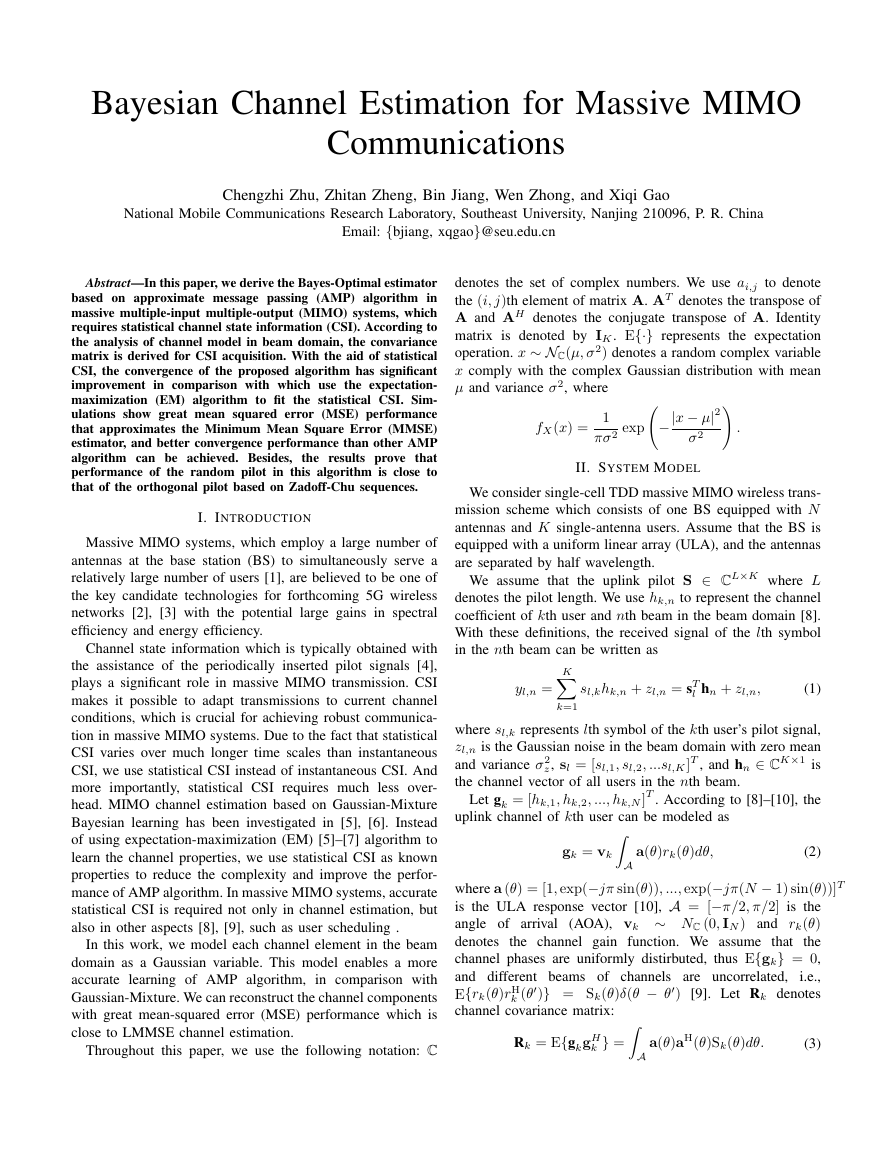
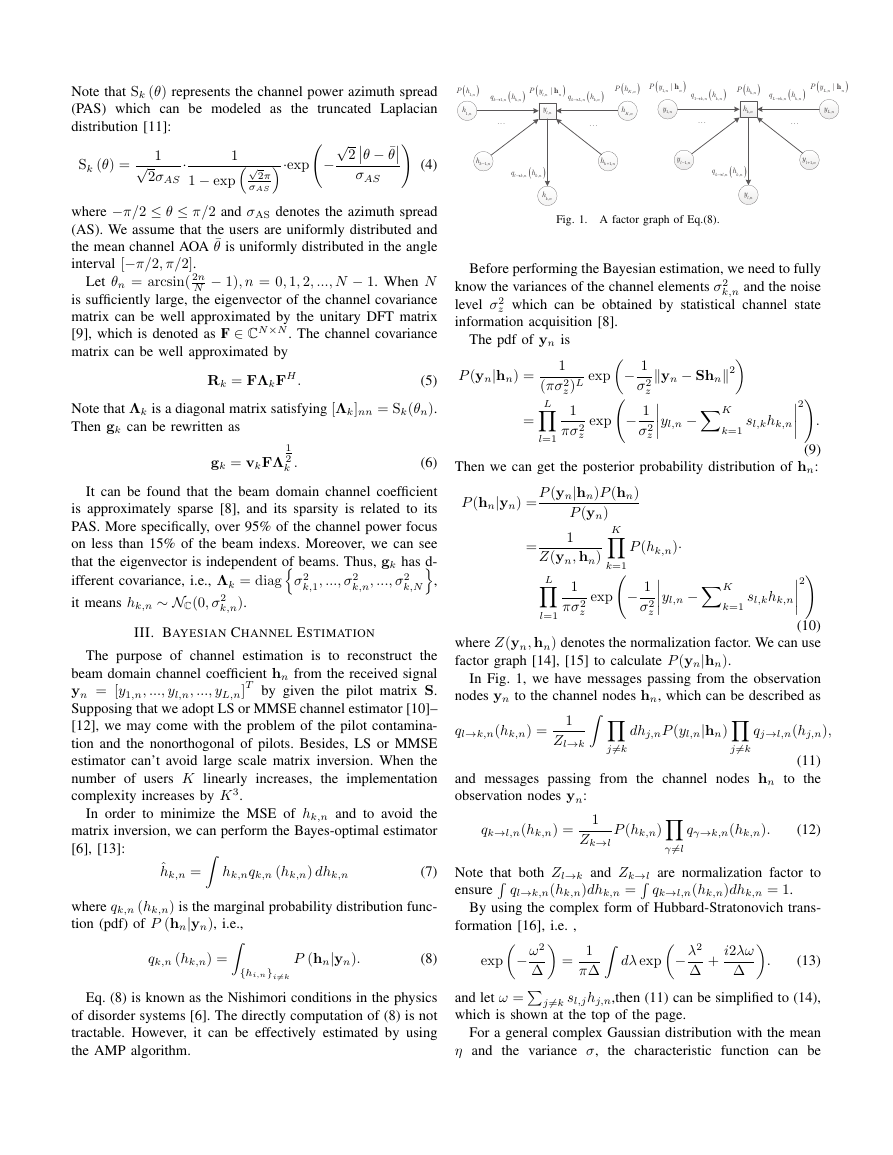
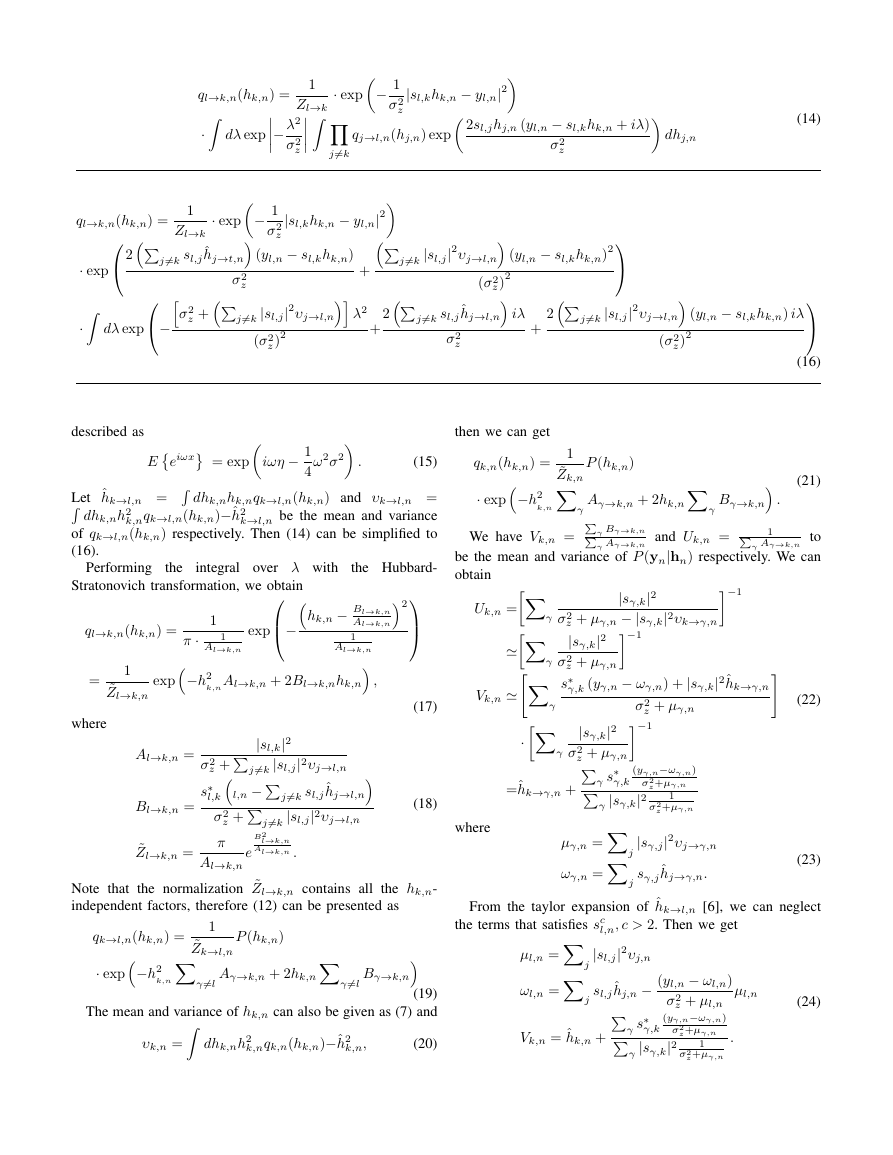
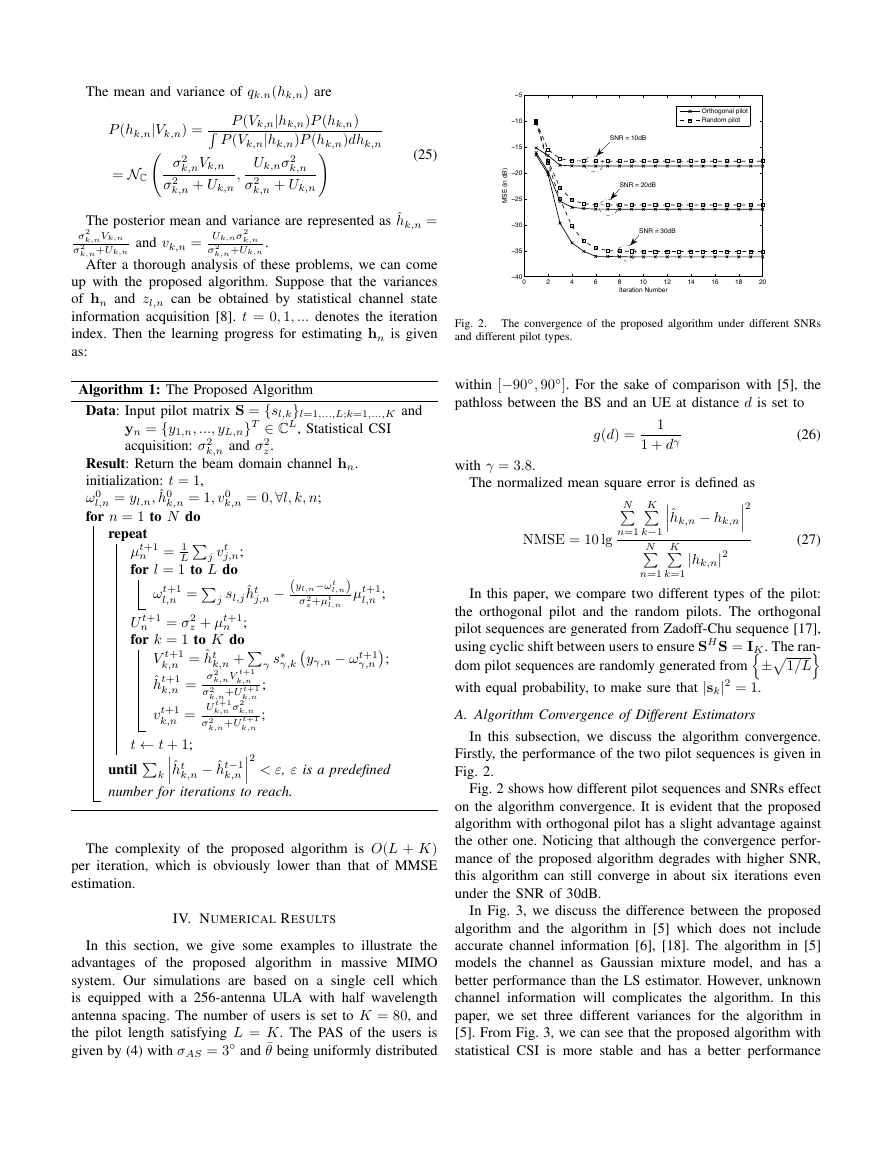
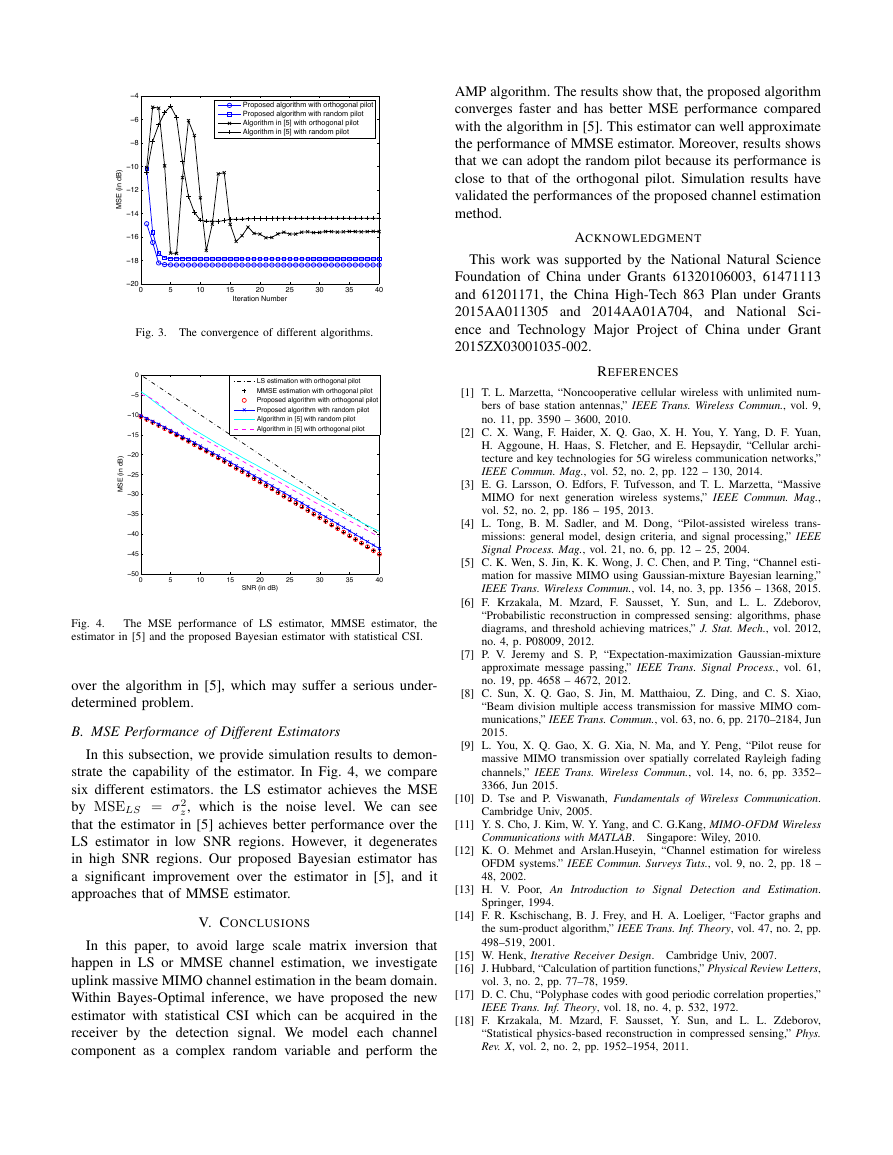





 2023年江西萍乡中考道德与法治真题及答案.doc
2023年江西萍乡中考道德与法治真题及答案.doc 2012年重庆南川中考生物真题及答案.doc
2012年重庆南川中考生物真题及答案.doc 2013年江西师范大学地理学综合及文艺理论基础考研真题.doc
2013年江西师范大学地理学综合及文艺理论基础考研真题.doc 2020年四川甘孜小升初语文真题及答案I卷.doc
2020年四川甘孜小升初语文真题及答案I卷.doc 2020年注册岩土工程师专业基础考试真题及答案.doc
2020年注册岩土工程师专业基础考试真题及答案.doc 2023-2024学年福建省厦门市九年级上学期数学月考试题及答案.doc
2023-2024学年福建省厦门市九年级上学期数学月考试题及答案.doc 2021-2022学年辽宁省沈阳市大东区九年级上学期语文期末试题及答案.doc
2021-2022学年辽宁省沈阳市大东区九年级上学期语文期末试题及答案.doc 2022-2023学年北京东城区初三第一学期物理期末试卷及答案.doc
2022-2023学年北京东城区初三第一学期物理期末试卷及答案.doc 2018上半年江西教师资格初中地理学科知识与教学能力真题及答案.doc
2018上半年江西教师资格初中地理学科知识与教学能力真题及答案.doc 2012年河北国家公务员申论考试真题及答案-省级.doc
2012年河北国家公务员申论考试真题及答案-省级.doc 2020-2021学年江苏省扬州市江都区邵樊片九年级上学期数学第一次质量检测试题及答案.doc
2020-2021学年江苏省扬州市江都区邵樊片九年级上学期数学第一次质量检测试题及答案.doc 2022下半年黑龙江教师资格证中学综合素质真题及答案.doc
2022下半年黑龙江教师资格证中学综合素质真题及答案.doc